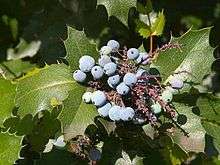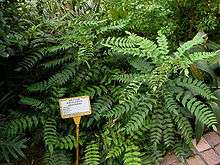Mahonia
| Mahonia | |
|---|---|
 | |
| Mahonia japonica fruit | |
| Scientific classification | |
| Kingdom: | Plantae |
| (unranked): | Angiosperms |
| (unranked): | Eudicots |
| Order: | Ranunculales |
| Family: | Berberidaceae |
| Genus: | Mahonia Nutt. |
| Type species | |
| Mahonia aquifolium | |
| Species | |
Mahonia is a genus of about 70 species of evergreen shrubs in the family Berberidaceae, native to eastern Asia, the Himalaya, North America and Central America.[1] They are closely related to the genus Berberis. Botanists disagree on the acceptability of the genus name Mahonia.[2] Several authorities argue plants in this genus should be included in the genus Berberis because several species in both genera are able to hybridize, and because when the two genera are looked at as a whole, there is no consistent morphological separation except simple vs compound leaves.[3] Mahonia typically have large, pinnate leaves 10–50 cm long with 5-15 leaflets, and flowers in racemes (5–20 cm long).
The genus name Mahonia honours the Philadelphia horticulturist Bernard McMahon who introduced the plant from materials collected by the Lewis and Clark Expedition.
The type species of the genus is Mahonia aquifolium, (Oregon grape) from the Pacific coast of North America.
Several species are popular garden shrubs, grown for their ornamental, often spiny, evergreen foliage, yellow flowers in autumn, winter and early spring, and blue-black berries. The flowers are borne in terminal clusters or spreading racemes, and may be among the earliest flowers to appear in the growing season.[4] The berries are edible, and rich in vitamin C, though with a very sharp flavor.[5] Although edible, the plants contain berberine, a compound found in many Berberis and Mahonia species which can cause vomiting, lowered blood pressure, reduced heart rate, lethargy, and other ill-effects when consumed in large quantities.[5]
Accepted Species
The following list includes all currently recognized species of the genus Mahonia as accepted by Tropicos, Missouri Botanical Garden as of February 2016, sorted alphabetically. For each, binomial name is followed by author citation.[6][7]
- Mahonia bealei (Fortune) Carrière
- Mahonia bodinieri Gagnep.
- Mahonia bracteolata Takeda
- Mahonia breviracema Y.S. Wang & P.G. Xiao
- Mahonia cardiophylla T.S. Ying & Boufford
- Mahonia conferta Takeda
- Mahonia decipiens C.K. Schneid.
- Mahonia duclouxiana Gagnep.
- Mahonia eurybracteata Fedde
- Mahonia fordii C.K. Schneid.
- Mahonia fortunei (Lindl.) Fedde
- Mahonia gracilipes (Oliv.) Fedde
- Mahonia hancockiana Takeda
- Mahonia imbricata T.S. Ying & Boufford
- Mahonia japonica (Thunb.) DC.
- Mahonia leptodonta Gagnep.
- Mahonia longibracteata Takeda
- Mahonia miccia Buch.-Ham. ex D. Don
- Mahonia microphylla T.S. Ying & G.R. Long
- Mahonia monyulensis Ahrendt
- Mahonia moranensis I.M. Johnst.
- Mahonia moranensis (Schult. & Schult. f.) I.M. Johnstone
- Mahonia napaulensis DC.
- Mahonia nepalensis DC.
- Mahonia nitens C.K. Schneid.
- Mahonia oiwakensis Hayata
- Mahonia paucijuga C.Y. Wu ex S.Y. Bao
- Mahonia polyodonta Fedde
- Mahonia retinervis P.G. Xiao & Y.S. Wang
- Mahonia setosa Gagnep.
- Mahonia shenii Chun
- Mahonia sheridaniana C.K. Schneid.
- Mahonia subimbricata Chun & F. Chun
- Mahonia taronensis Hand.-Mazz.
- Mahonia tenuifolia Loudon ex Steud.
- Mahonia tenuifolia (Lindl.) Loudon ex Fedde
- Mahonia tinctoria (Terán & Berland.) I.M. Johnst.
- Mahonia volcania Standl. & Steyerm.
- Mahonia volcanica Standl. & Steyerm.
Gallery
 Mahonia - Golden Abundance
Mahonia - Golden Abundance Fruits of Mahonia lomariifolia
Fruits of Mahonia lomariifolia Mahonia oiwakensis at Hong Kong Zoological and Botanical Gardens
Mahonia oiwakensis at Hong Kong Zoological and Botanical Gardens Flowers and buds of Mahonia aquifolium
Flowers and buds of Mahonia aquifolium
References
- ↑ Flora of China Vol. 19 Page 772 十大功劳属 shi da gong lao shu Mahonia Nuttall, Gen. N. Amer. Pl. 1: 211. 1818.
- ↑ "Mahonia". Germplasm Resources Information Network (GRIN).
- ↑ "Berberis Linnaeus". Flora of North America.
- ↑ RHS A-Z encyclopedia of garden plants. United Kingdom: Dorling Kindersley. 2008. p. 1136. ISBN 1405332964.
- 1 2 "Mahonia Oregon Grape, Hollyleaved barberry, Oregon Holly Grape, Oregon Holly PFAF Plant Database". www.pfaf.org. Retrieved 2016-02-17.
- ↑ "Mahonia". Tropicos. Missouri Botanical Garden. Retrieved 17 February 2016.
- ↑ "Mahonia". The Plant List. Missouri Botanical Garden. Royal Botanic Gardens, Kew. Retrieved 17 February 2016.
External links
| Wikimedia Commons has media related to Mahonia. |
| Wikispecies has information related to: Mahonia |